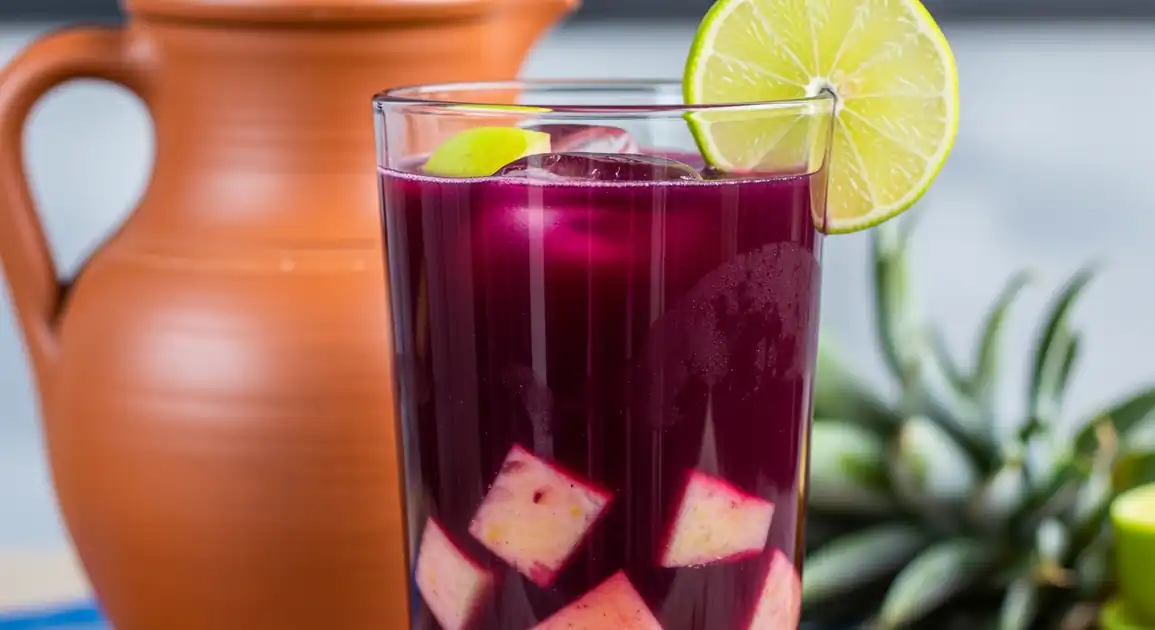Chicha Morada
Chicha Morada

Description
In Cusco, the heartland of the Andes, Chicha Morada is especially prominent. You'll find it everywhere, from tourist restaurants in the Plaza de Armas to traditional 'picanterías' in local neighborhoods and bustling stalls in the San Pedro Market. It's deeply intertwined with the region's history and connection to corn.
Dietary Information
Serving information
Serving style
Served cold by glass or pitcher. Often found alongside 'Frutillada' (strawberry chicha) during certain seasons. Ice is common; specify 'sin hielo' if preferred and unsure of water source.
Quick facts
Markets: ~8 AM - 5 PM. Restaurants/Cafes: ~11 AM - 9 PM.
Safety Tips
What to Look For
-
Vibrant, deep purple color
Indicates proper concentration of purple corn used and freshness. Avoid dull, brownish, or overly pale drinks.
-
Served chilled from a clean, covered container
Refrigeration slows bacterial growth. Covered containers prevent contamination from dust, insects, or handling.
-
Reputable source with good turnover
Busy restaurants or popular market stalls are more likely to prepare fresh batches daily.
-
Fresh-looking fruit pieces (if added)
Chopped fruit added to the glass should appear fresh, not old or mushy.
-
Clear inquiry about ice source
Especially outside major cities or reliable restaurants, ensure ice is made from purified or boiled water ('hielo de agua tratada/hervida'). If unsure, order 'sin hielo'.
What to avoid
-
Drinks left open or unrefrigerated for long periods
Increases the risk of bacterial contamination and spoilage, especially in warm climates.
-
Vendors with visibly poor hygiene
Dirty hands, cloths, utensils, or containers significantly increase contamination risk.
-
Sour or fermented smell/taste
Indicates spoilage or unintended fermentation. Chicha Morada should taste fresh and sweet/tart, not sour.
-
Excessively cloudy or murky appearance
While not perfectly clear, extreme cloudiness could suggest improper preparation or the beginning of spoilage.
-
Re-used serving glasses that aren't washed properly
Observe if glasses are washed thoroughly between customers, especially at market stalls.
Price information
Price range
Budget tips
- Find the best prices (around 3-5 PEN/glass) at San Pedro Market or local eateries offering 'menú del día' outside the immediate tourist center.
- Restaurants around the Plaza de Armas will charge significantly more (8-12 PEN/glass).
- A pitcher ('jarra') in a mid-range local restaurant might cost 12-18 PEN.
Value indicators
- Made fresh daily (ask!).
- Served in traditional clay cups ('kero') or glasses.
- Good balance of spice, fruit, and corn flavor.
- Offered at places popular with Cusqueñan locals, not just tourists.
Where to Find This Dish
San Pedro Market
Multiple juice and food stalls offer freshly made Chicha Morada, often at excellent prices.
Mercado Central de San Pedro
Morning (9 AM - 1 PM)
San Blas Neighborhood
Many cafes and small restaurants in this artisanal area serve good quality Chicha Morada.
Plazoleta de San Blas, Cuesta de San Blas
Lunchtime, Afternoon
Local Picanterías (various neighborhoods)
Traditional eateries specializing in regional food almost always serve excellent, authentic Chicha Morada.
Restaurants slightly away from Plaza de Armas
Lunch (12 PM - 4 PM)
Vendor Tips
- Compare prices between stalls at San Pedro market.
- Ask '¿Es de hoy?' (Is it made today?) to gauge freshness.
- Observe cleanliness carefully, especially regarding ice and glass washing at market stalls.
- Try it as part of a 'menú' for the best value.
How to Order
Regional Variations
-
Emphasis on Spices
(Más Especiado)
Some local Cusco preparations might have a slightly stronger emphasis on cinnamon and cloves compared to coastal versions.
-
Use of Local Fruits
(Uso de Frutas Locales)
While pineapple and apple are standard, occasionally other local Andean fruits might be subtly incorporated depending on the season and cook's preference.
Cultural context
History
The use of purple corn in Peru dates back thousands of years, even pre-dating the Inca Empire. Chicha Morada as a prepared beverage likely evolved over centuries from ancient Andean traditions. While fermented 'chicha' was historically common, this sweet, boiled version gained widespread popularity as a daily drink and symbol of Peruvian culinary identity. It's now consumed nationwide, from homes to restaurants, representing a connection to Peru's rich agricultural heritage.
Local significance
Purple corn ('maíz morado') is an important Andean crop with deep cultural roots in the Cusco region. Chicha Morada represents this heritage and is a source of local pride.
Eating customs
- Commonly ordered alongside typical Cusco dishes like 'Cuy' (guinea pig), 'Adobo Cusqueño', or trout.
- Enjoyed slowly throughout the meal.